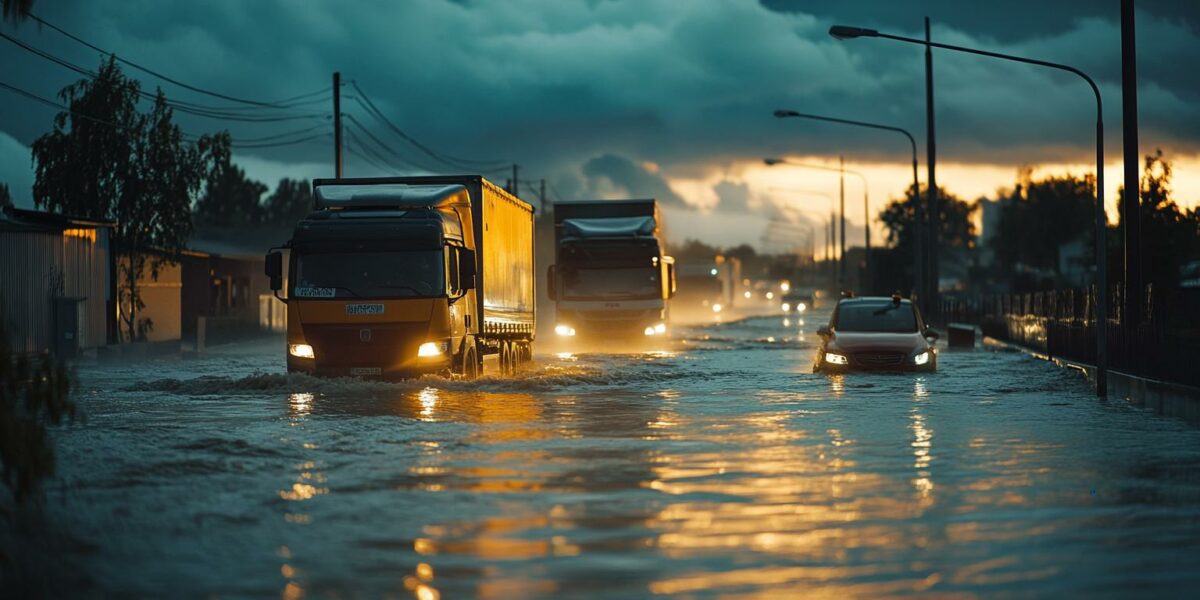Rising Climate Challenges to Fast Delivery Services
In recent years, extreme weather events have increasingly disrupted fast delivery services. From heatwaves in Houston to hurricanes in Florida, these climatic changes are causing significant delays. Customers who once expected their orders in two days are now facing unpredictable waiting times.
Logistical companies are experiencing severe disruptions in their supply chains. A survey conducted by Breakthrough found that extreme weather is the top challenge for shippers and carriers. The industry is projected to face costs up to $100 billion in 2024 due to these disruptions.
Jenny Zanden, COO of Breakthrough, highlighted that sustainability and climate-related disruptions are now driving the need for more fuel-efficient and strategic transportation solutions. This shift marks a significant change from last year’s focus on reducing costs due to volatile diesel prices.
The Panama Canal, a crucial global transportation route, has also been affected by drought conditions, exacerbating the challenges for major retailers trying to keep their supply chains intact and their stores stocked.
Technological Adaptations in Retail Logistics
Walmart faced a major challenge during a snowstorm in Sparks, Nevada, which led to the closure of Donner Pass. This disruption halted grocery deliveries, prompting Walmart to use predictive analytics and artificial intelligence to optimize its last-mile strategies.
Parvez Musani, Walmart’s senior vice president, explained that their new technology allows for quick decision-making and action, ensuring minimal impact on customers. This system enables Walmart to reroute trucks and realign warehouses to maintain delivery efficiency during adverse weather.
- Identified 85 stores across Nevada, California, and Oregon
- Utilized four specific distribution centers for workload management
- Offered alternate driving routes for timely deliveries
Target has also been proactive in adjusting its logistics to counter delays caused by storms. By pre-positioning inventory and using stores as hubs, Target ensures faster delivery fulfillment and maintains stocked supplies in high-demand areas.
A Target spokesman emphasized the importance of their various fulfillment options, such as same-day delivery and next-day delivery, which provide customers with multiple ways to receive products quickly, even during adverse weather conditions.
Addressing Heat-Related Challenges in Warehouses
Rising temperatures have become a pressing issue for retailers like Amazon. Instances of high heat in warehouses have raised concerns about working conditions. Amazon claims its facilities are climate-controlled, with temperatures kept within safe limits.
Amazon has implemented several measures to ensure the well-being of its delivery associates. These include providing electrolyte powder, insulated tumblers, cooling bandanas, and sunscreen. The company also mandates additional breaks during extreme heat.
Predictive analytics play a crucial role in maintaining Amazon’s fast shipping times. Despite adverse weather, Amazon achieved record shipping speeds for Prime delivery in early 2024, with over two billion items delivered within two days globally.
An Amazon spokesperson highlighted the company’s agility in placing in-demand products in non-impacted areas and monitoring inventory levels for essential items, ensuring timely delivery despite climatic challenges.
Sustainability and Cost Efficiency Through Technology
Despite the added costs of mitigating adverse weather impacts, maintaining customer loyalty by honoring shipping promises proves beneficial in the long run. Technology aids in achieving this balance.
Parvez Musani stated that utilizing AI-based platforms makes it easier to manage both top-line and bottom-line goals. The aim is to create the fastest delivery network at the lowest cost, combining scale and technology for optimal efficiency.
Integrating sustainability into logistics strategies not only addresses climate-related disruptions but also enhances overall operational efficiency. As companies adapt to these changes, they can better serve their customers while mitigating environmental impacts.
The future of fast delivery hinges on the ability to navigate and adapt to the evolving climate landscape. By leveraging technology and sustainable practices, the industry can continue to meet customer expectations while contributing to environmental stewardship.



genesis
Why does this sound like the beginning of a sci-fi novel where weather controls shipping and commerce? 😂
TristanRadiance
Climate change is affecting every aspect of our lives, including shopping. Time to rethink our consumption habits!
peppersymphony
Amazon’s measures for their workers sound good on paper, but are they really enough? Anyone here working in their warehouses?
JosephDrifter
It’s good to see companies like Walmart and Target using tech to tackle these problems. Innovation is key!
camila
Great insight into the challenges faced by retailers. Thanks for sharing this detailed analysis!
cooper
Isn’t it ironic that the very industry contributing to climate change is now being severely affected by it? 🤔
felix
So, what can customers do to help mitigate these issues? Are there alternative shipping options that are more eco-friendly?
SerenityFrost
Wow, $100 billion in costs? That’s insane! 😲 How are smaller businesses coping with these disruptions?
adeline_eclipse
This is quite alarming! What are the logistics companies doing to reduce their carbon footprint while ensuring fast delivery?